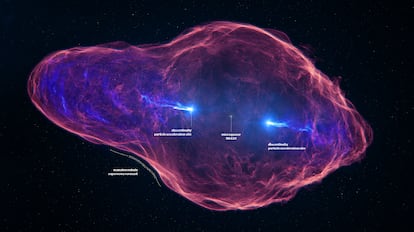The incredible story told by a supernova remnant
These phenomena are beautiful, and also very interesting from a physical point of view, as they are full of surprises

I like to imagine scenes. For example, I see one of the cave artists of Altamira, with their eyes accustomed to the darkness, going out one summer night to observe the sky and finding — where there had been nothing the night before — a great new light, near what we now call Altair, one of the stars of the Summer Triangle in the constellation of Aquila. After that night, it would take just 17,000 years before one of their descendants could understand — and not completely — what had happened. In the same way that archaeology allows us to understand the cave artists of Altamira, astrophysical archaeology allows us to learn the history of that star through its supernova remnants.
The supernova we are referring to did not explode 17,000 years ago, but approximately 18,000 years before that night at the entrance to the Altamira cave. At that time, one of the components of a binary system — composed of two stars dozens of times more massive than the Sun — gave rise to a supernova. And, on that night only, the glow of the great explosion reached Earth.
Today, what we see as the remains of that event is quite different. Only about 35 years ago, we discovered a diffuse emission in that area — like a large cloud more than 700 light years across — using a radio telescope. The nebula was named the Manatee Nebula, but it’s less poetic name is Westerhout 50 (in honor of the astronomer who discovered it). In truth, it does look very similar to a manatee with its small head, large body with crossed front legs, and prominent tail. At the center of this nebula, a small star (or so it was initially thought) was already known to exist, having been discovered around 1975 with an X-ray telescope. This object quickly gave rise to many more studies, one of them published by two American astronomers whose surnames begin with the letter S: Charles Bruce Stephenson and Nicholas Sanduleak, who gave the “stellar object” the number 433 in their catalogue, which is why we know it today as SS433.
SS433 was identified as a binary star composed of a black hole slightly more massive than the Sun, the remnant of that supernova explosion, and a star about 10 times more massive than our star. From the supernova (and previous events), we are left today with its remnants, the Manatee Nebula, which is also known as SNR G039.7-02.0 (SNR for supernova remnant, G for the initial of the author of a catalogue of the objects, D. Green; and the number for its coordinates in the sky). Both stars in SS433 are orbiting each other with a period of about 13 days, at a distance approximately equal to one third of the distance between the Sun and Mercury. Obviously, the presence of a black hole is so incredible that it sparked many subsequent studies: even the writer Arthur C. Clarke called SS433 one of his “seven wonders of the universe.”
But the black hole is not even the most amazing thing about this system. Two large spiral structures emerge from it in opposite directions, reaching up to about 30 light years. By comparison, at that distance in our environment, there are about 200 stars. But in SS433, there is material ejected by the black hole. These large structures are actually very thin electron beams or jets travelling at a quarter of the speed of light. They are called relativistic jets: this adjective is given because at the speeds we mentioned they have special properties that cannot be understood with classical physics, but with the theory of relativity. The jets emerge from the vicinity of the black hole and, as if they were water from a hose, they form those spirals that we mentioned. The formation of the jets is explained by magnetic phenomena around the black hole, which swallows material from its companion star, heating it first to very high temperatures that cause its ionization. To compare it with something more terrestrial, the energies of the electrons in SS433 and its surroundings reach values tens of times greater than what we have been able to achieve in the Large Hadron Collider (LHC). Although, to be precise, the LHC accelerates protons, which belong to the family of hadrons, and here we were talking about electrons, which are leptons.
Between the edges of those electron jets and the limits of the Manatee Nebula, not much was visible until a few years ago. Only a couple of years ago, a telescope operating in gamma rays — much more powerful than the X-rays that we associate more with a doctor’s visit — discovered emission at both ends of the nebula, right in the same direction as the electron jets, but at a distance of between around 75 and 200 light years from the black hole, far beyond the end of the jets. That area of gamma ray emission is not at the edges of the nebula, but where the extensions that create what we identify as the head and tail of the manatee begin, protuberances that emanate from a more or less spherical main body.
Given its alignment, this gamma-ray emitting structure has every chance of being related to the electric currents — the relativistic electron jets. The currents seemed short-circuited, but in reality they continue beyond the area where we had seen them, until they encounter a concentration of material that we cannot see. And here begins the latest mind-blowing astrophysical-archaeological story. The energy of the photons that we detected in that area with gamma-ray telescopes is so high that they could not have been created by the jets coming out of SS433, since these must have been losing energy as they traveled the 75 light years.
That energy of the gamma ray emission, and its spatial structure, indicates that the electrons of the original jet must be accelerated by a process that we do not properly understand yet. The belief is that we have a particle accelerator in the middle of nowhere, increasing the energy of the electrons of the SS433 jet, and these electrons are colliding against particles, such as hydrogen atoms and photons that swarm around that area, and finally in the interaction, tremendously energetic photons are created that travel freely through space. Among them would be the gamma rays that we saw a couple of years ago. Since this emission is seen on both sides of the nebula, at exactly the same distance from the black hole, it is surely telling us another chapter of the story of SS433, perhaps a large ejection of material prior to the supernova explosion. But we do not have much evidence of that yet.
That brings us to the end. The universe, even with just one object, tells us extraordinary stories. We just have to dig further and collect data to write all of its chapters. That story may have more consequences than what seems obvious at first glance. For example, understanding the history of an object like SS433 can even explain how galaxies form, and how life appeared on a small planet lost on the outskirts of a regular old galaxy.
Sign up for our weekly newsletter to get more English-language news coverage from EL PAÍS USA Edition
Tu suscripción se está usando en otro dispositivo
¿Quieres añadir otro usuario a tu suscripción?
Si continúas leyendo en este dispositivo, no se podrá leer en el otro.
FlechaTu suscripción se está usando en otro dispositivo y solo puedes acceder a EL PAÍS desde un dispositivo a la vez.
Si quieres compartir tu cuenta, cambia tu suscripción a la modalidad Premium, así podrás añadir otro usuario. Cada uno accederá con su propia cuenta de email, lo que os permitirá personalizar vuestra experiencia en EL PAÍS.
¿Tienes una suscripción de empresa? Accede aquí para contratar más cuentas.
En el caso de no saber quién está usando tu cuenta, te recomendamos cambiar tu contraseña aquí.
Si decides continuar compartiendo tu cuenta, este mensaje se mostrará en tu dispositivo y en el de la otra persona que está usando tu cuenta de forma indefinida, afectando a tu experiencia de lectura. Puedes consultar aquí los términos y condiciones de la suscripción digital.











































